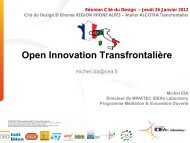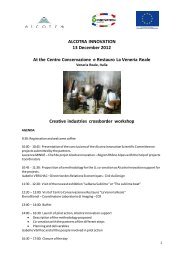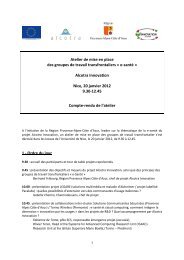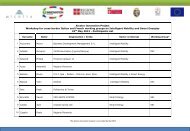Best practices Database for Living Labs - ALCOTRA - Innovation
Best practices Database for Living Labs - ALCOTRA - Innovation
Best practices Database for Living Labs - ALCOTRA - Innovation
You also want an ePaper? Increase the reach of your titles
YUMPU automatically turns print PDFs into web optimized ePapers that Google loves.
Figure 7: Sample <strong>Living</strong> Lab’s trial implementation workflow (from: [24])<br />
After the institutional definition of the PPP, an initial phase of brainstorming with local stakeholders is<br />
realized, aimed at making them aware of the goals and features of the prospective solution concept. As a<br />
result of this first activity, several key aspects of the preliminary usage scenario(s) envisaged <strong>for</strong> the<br />
prototype may be confirmed, refined or radically changed.<br />
Then follows the initial development of the technical architecture (only at mock-up level in this stage) and<br />
its validation with the end users in order to get additional feedback from the illustration of the related<br />
usage potential. A notable remark is that up to this moment, only the PPP stakeholders have been involved<br />
in the group discussion and no single code line has been written as yet.<br />
The next activity is the actual development and installation of the specific application on real devices, in<br />
order to carry out the ‘live’ demonstrations of its main features as required. Some training sessions may<br />
also be needed in order to support technology deployment in this phase. A number of real working sessions<br />
are recorded, and several concrete suggestions <strong>for</strong> improving usability as well as functionality of the system<br />
are collected. Bugs fixing and the provision of requested improvements (with or without a new battery of<br />
field tests <strong>for</strong> further refining the architectural and structural aspects) ultimately leads to the final<br />
prototype.<br />
3.3 The IBBT Research Cycle<br />
One of the earliest examples of <strong>Living</strong> <strong>Labs</strong> as testing and experimentation plat<strong>for</strong>ms <strong>for</strong> technologies and<br />
services in early stages of the innovation process comes from IBBT, the leading Belgian Institute of Applied<br />
Technologies [25]. In this perspective, the basic research cycle is based on four consecutive (and iterative)<br />
steps:<br />
The project is co-funded by the ERDF<br />
Page 17 of 78









